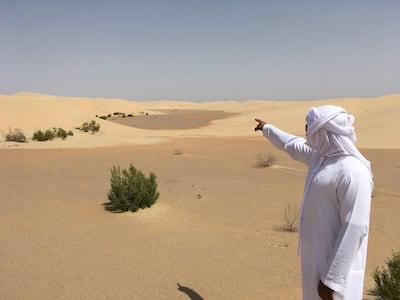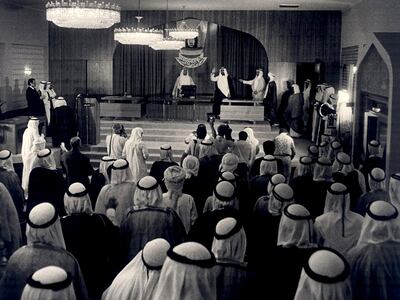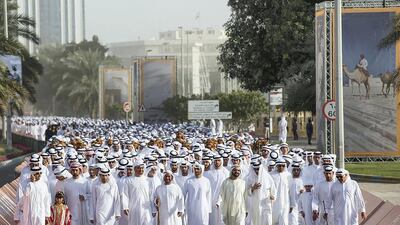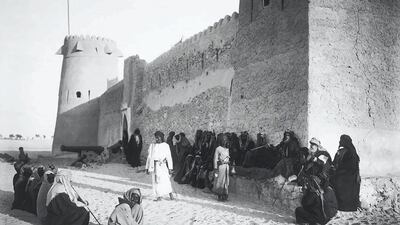The re-opening of Qasr Al Hosn, the old fort at the heart of Abu Dhabi, after 10 years of restoration, provides opportunity for a moment of reflection on its significance. Qasr Al Hosn has been the dynastic seat of the Al Nahyans, the ruling family of Abu Dhabi, since the late 18th century. It was the first building erected when the city was founded; indeed, Abu Dhabi grew in the shadow of its white walls. Qasr Al Hosn is thus a symbol of the political and communal identity of Abu Dhabi.
Legend tells how a Bani Yas hunting party chased a gazelle – dhabi in Arabic – onto the island which was to take its name from this incident – Abu Dhabi, or "father of the gazelle". There they found fresh water and dug a well. Sheikh Dhiyab bin Isa, upon hearing the news, encouraged his people to establish a new settlement. By 1761, a village of 20 palm-frond houses had sprung up and within two years, Abu Dhabi was described as a thriving town of about 400 dwellings.
Archaeological and historical evidence, however, suggests that Abu Dhabi is much older. Pottery dating back to between the eighth and 13th centuries has been found near Abu Dhabi Golf and Equestrian Club. A Portuguese document dated December 14, 1621, refers to the "island of gazelles". Nevertheless, there does not seem to have been a permanent settlement on the island until the 18th century.
The predecessor of Qasr Al Hosn as the dynastic seat of the Bani Yas might have been the fort of Hosn Al Sirra. This little-known site lies in the desert sands to the east of Madinat Zayed and north of Liwa oasis. It has been identified as the 17th century Hosn Al Dhafra first mentioned by the Omani historian Sirhan bin Said. The site was first explored by the Abu Dhabi Archaeological Islands Survey (ADIAS) in 1994 at the request of the Ruler’s Representative of the Western Region.

A full survey was recently conducted by the Department of Culture and Tourism – Abu Dhabi, which demonstrated that Hosn Al Sirra flourished between the 14th and 16th centuries. The ruins of the fort, while buried deep underground, are surrounded by extensive and impressive scatters of pottery shards, evidence of seasonal Bedouin encampments, when sections of the tribe came together around the fort of the ruling family. Miles out into the desert, it is only accessible by four-wheel drive and, although there is now not much to see, you can imagine the landscape filled with the low, black tents of the Bani Yas.
But in 1795 Sheikh Dhiyab bin Isa's son, Sheikh Shakhbut bin Dhiyab, decided to build on his father’s legacy. He moved to Abu Dhabi, where he built Qasr Al Hosn. Historic photographs and maps show that it was originally a square structure with round and square towers. Very little now survives of the original fort, apart from the northeast tower, which appears in the background of a 1904 photograph. Recent dating of the coral used to build the tower places it in the late 18th century.
The migration of the Bani Yas from the Liwa oasis to Abu Dhabi, and the transfer of dynastic authority from Hosn Al Sirra to Qasr Al Hosn, is told for the first time in the new permanent exhibition now open to the public.
By 1820, Abu Dhabi had grown into a town of 10,000 souls. Archaeological evidence for Abu Dhabi at the time of Shaikh Shakhbut bin Dhiyab has been found on the islands of Hudayriat, Ramhan and Saadiyat. ADIAS, for example, found scatterings of pot shards on the surface of Saadiyat Island, which were later examined by DCT – Abu Dhabi. These likely belong to a small settlement of palm-frond houses making full use of the mangroves, an important source of fuel and building materials for the growing town.
Pottery and coins found during recent excavations at Qasr Al Hosn testify to the expanding trade of Abu Dhabi. Blue and white porcelain from China and sponge-painted bowls from Europe attest to Abu Dhabi's participation in global networks that spanned the Pacific and Atlantic oceans. Mangrove poles were brought from East Africa for the roof and several Zanzibari coins have been found. A selection of these objects are now on display in the newly opened permanent exhibition.
This flourishing trade was supported by the growth of the pearling industry, which peaked between the 1880s and 1910s. Abu Dhabi became the leading pearling centre of the Trucial Coast, with about a third of the combined fleet and a quarter of the total labour force, far higher than any of the other emirates.
The peak of the pearling industry coincided with the reign of Sheikh Zayed bin Khalifa, the grandfather of the founder of the UAE. An American missionary who met him in Abu Dhabi in 1901 described him as “a well-preserved old man… we found him genial, hospitable and very intelligent”. Sheikh Zayed bin Khalifa used the pearling wealth of Abu Dhabi to buy land and build forts in the oases of Al Ain, including Jahili and Mezyad, which were built in the style of Qasr Al Hosn and still exist to this day.
A British visitor who met Shaikh Zayed bin Khalifa observed that “it was his habit, in the hot season at all events, to conduct the administrative business of his principality and dispense justice sitting out in the open in the early mornings”. In 1904, this very scene was captured on camera by a German traveller. It has since become one of the most iconic images of Qasr Al Hosn.
____________
Read more from Timothy Power:
Ancient routes take a 2,500-year detour across the Arabian Peninsula to Abu Dhabi
The reconstruction of Al Nuri mosque reclaims a rich and humane legacy
How a 1,000-year-old mosque anchors the UAE in human history
____________
The good times were not to last. The First World War, the growth of the Japanese cultured pearl industry and the Great Depression decimated the Gulf's trade in freshwater pearls. The 1920s and 1930s were bleak as a result. Then in 1939, Abu Dhabi agreed the first major concession to begin exploring for oil and a welcome new source of revenue began to trickle in.
Sheikh Shakhbut bin Sultan, the brother of the country’s founder, used some of this money to massively expand Qasr Al Hosn. The outer fort was completed by 1942. It appears in a number of visitors’ descriptions and colour photographs from the 1950s and 1960s. In one such description, British diplomat Edward Henderson and explorer Wilfred Thesiger took a boat from Dubai to Abu Dhabi and talked of how they “anchored off the foreshore and went ashore in the tiny canoe-like dug-out through the surf. We walked through the soft sand half a mile or so to the big fort or palace which then seemed to dominate the tiny town… Shaikh Shakhbut, the Ruler, was at his most charming and courteous… (He) would hold forth on any subject and had the shrewdest questions to ask.”

Vivid accounts of Qasr Al Hosn as the home of Sheikh Shakhbut are to be found in the memoirs of the first western settlers. Many of these were written by the wives of oil company representatives, such as Susan Hillyard and Honor Cowell, who were frequent visitors to the fort. Special mention must be made of Jocelyn Henderson, who still lives in the house her husband built in Sheikh Zayed's royal stables compound.
When Sheikh Shakhbut’s brother, Sheikh Zayed bin Sultan, became the ruler of Abu Dhabi in 1966, he moved his formal residence to Manhal Palace. Sheikh Zayed nevertheless continued to use Qasr Al Hosn as the political centre of the emirate of Abu Dhabi. In 1968, he built the National Consultative Council on the site where his grandfather used to hold his majlis in the shade of the old fort’s walls.

The opening of the Cultural Foundation on the site in 1981 marks the beginning of Qasr al Hosn's transformation into a heritage monument, a process furthered in 2013 by the inauguration of the annual Qasr Al Hosn Festival. With the opening of the old fort to the public, after more than a decade of restoration and rehabilitation, this process is now complete. For so long a symbol of the political and communal identity of Abu Dhabi, Qasr Al Hosn has emerged from the hoardings as a monument to Emirati heritage and national pride.
Dr Timothy Power is an archaeologist and historian focusing on Arabia and the Islamic world and an associate professor at Zayed University in Abu Dhabi. His book, A History of the Emirati People, is due to be published in 2020


